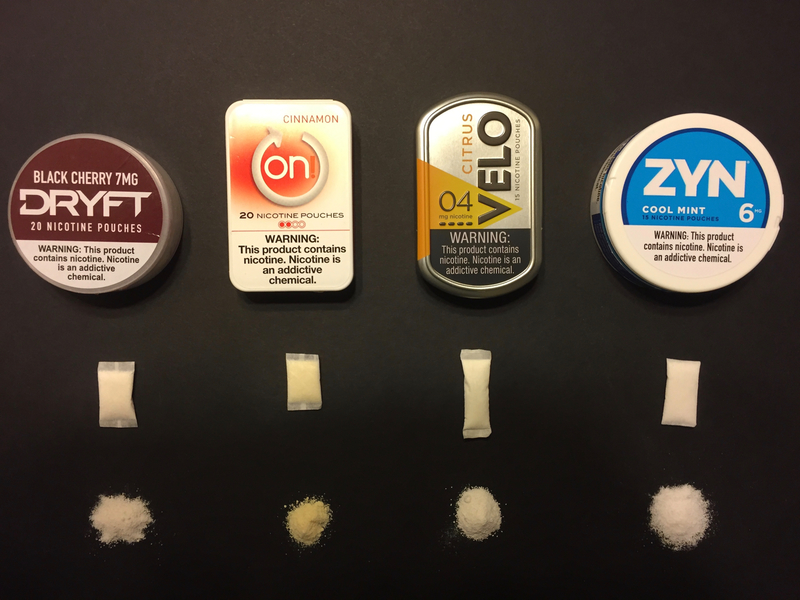A new product category is emerging with several large tobacco companies now selling “tobacco-free” nicotine pouches. These products are sold as pre-portioned pouches similar to snus, but instead of containing tobacco leaf, are filled with white nicotine-containing powder (Figure 1). The pouches are placed between the lip and gum, and require no spitting or refrigeration.1,2 At least five large tobacco manufacturers currently sell nicotine pouch products. British American Tobacco sells Lyft in the United Kingdom (UK) and Sweden2,3, and Velo (through RJ Reynolds Vapor Company) in the United States (US).4 Swedish Match sells Zyn in Europe and the US5, Kretek International sells Dryft in the US1, and Japan Tobacco International sells Nordic Spirit in Sweden.6 Moreover, Altria recently agreed to acquire 80% of the On! nicotine pouch brand, currently sold in Sweden, Japan, and the US.7
Figure 1.
Product packaging, nicotine pouch, and pouch contents for Dryft Black Cherry 7 mg, On! Cinnamon 2 mg, Velo Citrus 4 mg, and Zyn Cool Mint 6 mg nicotine pouches.
Nicotine pouches are sold in a variety of fruit (e.g., black cherry, citrus) and other (e.g., peppermint, coffee) flavors,1,4,8 and vary in nicotine content per pouch (e.g., Dryft: 2 mg and 7 mg1; Velo: 2 mg and 4 mg4; Lyft: 4 mg and 6 mg2). Companies use descriptors such as “tobacco-free”8 or “tobacco leaf-free”4 in product marketing. Regarding ingredients, Zyn’s website says their pouches contain “pharmaceutical-grade” nicotine salt, hydroxypropyl cellulose, micro crystalline cellulose, maltitol, gum arabic, sodium carbonate, sodium bicarbonate, Acesulfame K, and food-grade flavorings.8 Similarly, Velo discloses that their products contain “nicotine derived from the tobacco plant, microcrystalline cellulose, water, salt, sucralose, citric acid, and artificial flavor.”4 Online marketing highlights how nicotine pouches can be used anywhere and how batteries and devices are not needed.1,8 In the United States, the products appear to be priced comparable to a pack of cigarettes. During the summer of 2019, we purchased Velo and Zyn (US$3.76 and US$5.11, respectively) in local retailers (North Carolina, USA), and Dryft and On! (US$5.54 and US$6.50, respectively) online.
Because they are not combusted and contain no tobacco leaf, nicotine pouches have the potential to be a lower-risk product. However, we are unaware of any independent testing of product constituents, exposure, or biomarkers of harm. Moreover, research evaluating nicotine delivery is lacking.
In the US, these products are presumably classified as tobacco products because they contain tobacco-derived nicotine.9 It is unclear how nicotine pouches are classified and regulated in other countries, and whether existing tax, youth-access, marketing, and other tobacco control policies apply.
Research is needed to determine if nicotine pouches can help smokers transition from cigarettes to a less harmful nicotine source, or if these products would instead be used situationally by smokers, leading to dual-use. Moreover, because nicotine pouches are sold in a variety of fruit flavors and can be used discreetly, these products may appeal to youth and young-adult nonsmokers. As seen with e-cigarettes (e.g., Juul) in the US10, novel nicotine products have potential for rapid uptake by youth and young adults. Monitoring of product use and marketing are needed to ensure that nicotine pouches do not promote nicotine addiction among non-smokers, especially youth.
ACKNOWLEDGEMENTS
ABS is supported by the National Institute on Drug Abuse of the National Institutes of Health under Award Number F31DA045424. The content is solely the responsibility of the authors and does not necessarily represent the official views of the National Institutes of Health or NORC at the University of Chicago.
REFERENCES
- 1.Kretek International Inc. Dryft. https://getdryft.com Accessed July 24, 2019.
- 2.British American Tobacco UK Limited. LYFT. https://www.lyft.co.uk Accessed July 24, 2019.
- 3.British American Tobacco Northern Europe Area. LYFT. https://www.golyft.se/en/ Accessed July 24, 2019.
- 4.RJR Vapor Co. VELO. https://www.velo.com/index.html Accessed July 24, 2019.
- 5.Swedish Match. Q1 2019 Interim Report. https://www.swedishmatch.com/globalassets/reports/interim-reports/2019_q1_swedish-match_en.pdf Accessed July 17, 2019.
- 6.Japan Tobacco International. JTI Sweden and Nordic Snus. https://www.jti.com/europe/sweden Accessed July 22, 2019.
- 7.Altria. Altria enters growing oral nicotine products category with on! pouch product. http://investor.altria.com/file/Index?KeyFile=398170376 Accessed July 23, 2019.
- 8.Swedish Match North America LLC. Zyn. https://www.zyn.com/us/en/ Accessed July 24, 2019.
- 9.Food and Drug Administration. Deeming Tobacco Products To Be Subject to the Federal Food, Drug, and Cosmetic Act, as Amended by the Family Smoking Prevention and Tobacco Control Act. https://www.govinfo.gov/content/pkg/FR-2016-05-10/pdf/2016-10685.pdf. Published 2016. Accessed October 14, 2019. [PubMed]
- 10.Walley SC, Wilson KM, Winickoff JP, Groner J. A Public Health Crisis: Electronic Cigarettes, Vape, and JUUL. Pediatrics. 2019;143(6). [DOI] [PubMed] [Google Scholar]



